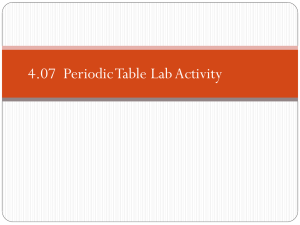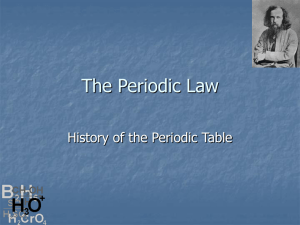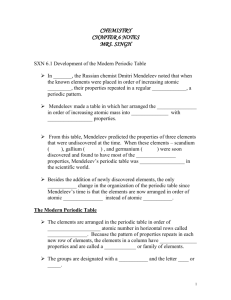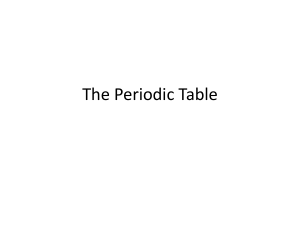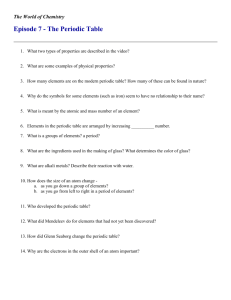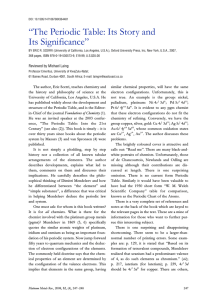downloading
advertisement
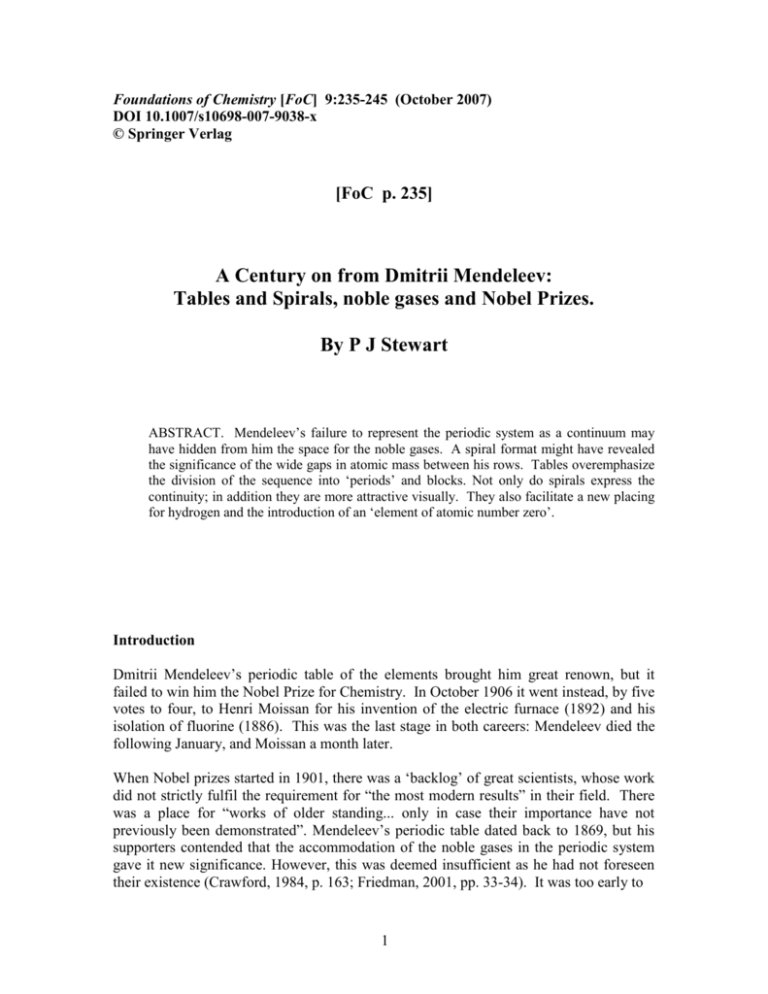
Foundations of Chemistry [FoC] 9:235-245 (October 2007)
DOI 10.1007/s10698-007-9038-x
© Springer Verlag
[FoC p. 235]
A Century on from Dmitrii Mendeleev:
Tables and Spirals, noble gases and Nobel Prizes.
By P J Stewart
ABSTRACT. Mendeleev’s failure to represent the periodic system as a continuum may
have hidden from him the space for the noble gases. A spiral format might have revealed
the significance of the wide gaps in atomic mass between his rows. Tables overemphasize
the division of the sequence into ‘periods’ and blocks. Not only do spirals express the
continuity; in addition they are more attractive visually. They also facilitate a new placing
for hydrogen and the introduction of an ‘element of atomic number zero’.
Introduction
Dmitrii Mendeleev’s periodic table of the elements brought him great renown, but it
failed to win him the Nobel Prize for Chemistry. In October 1906 it went instead, by five
votes to four, to Henri Moissan for his invention of the electric furnace (1892) and his
isolation of fluorine (1886). This was the last stage in both careers: Mendeleev died the
following January, and Moissan a month later.
When Nobel prizes started in 1901, there was a ‘backlog’ of great scientists, whose work
did not strictly fulfil the requirement for “the most modern results” in their field. There
was a place for “works of older standing... only in case their importance have not
previously been demonstrated”. Mendeleev’s periodic table dated back to 1869, but his
supporters contended that the accommodation of the noble gases in the periodic system
gave it new significance. However, this was deemed insufficient as he had not foreseen
their existence (Crawford, 1984, p. 163; Friedman, 2001, pp. 33-34). It was too early to
1
[FoC p. 236]
Series
Gr. 0
0
x
1
2 {*}
y
K
5 {3}
Gr. IV
Gr. V
Gr. VI
Gr. VII
Be
B
C
N
O
F
Mg
Ca
(Cu)
6 {4}
7 {5}
Kr
8 {6}
Xe
Rb
Sr
Cs
-
11{9}
12{10} -
Hg
Ra
Zr
Yb{Er}
Nb
Ce
Group VIII
Mo
-
Th
Ru, Rh, Pd, [Ag]
I
-
W
Bi
-
-
-
Ta
Fe, Co, Ni, [Cu]
Br
Te
-
Pb
Cl
Mn
Se
Sb
-
S
Cr
As
Sn
Tl
-
P
V
Ge
In
La{Di}
-
(Au)
-
Y
Ba
Si
Ti
Ga
Cd
-
Al
Sc
Zn
(Ag)
9 {7}
10{8}
Gr. III
Na
Ne
Ar
Gr. II
H
Li
He
3 {1}
4 {2}
Gr. I
-
-
-
-
-
Os, Ir, Pt, [Au]
-
U
Figure 1: Comparison of Mendeleev’s tables of 1870 and 1904. Bold: added/changed in
1904. ( ) brackets 1870. [ ] brackets 1904. { } replaced 1904. * labeled ‘typical
elements’, 1870. x = the ether. y = coronium.
point to its value in classifying the decay products of uranium and thorium, of which
about twenty had been observed by 1906, but in any case, Mendeleev had refused to
recognize radioactive transmutation.
Apart from updating his textbook and publishing occasional short articles, Mendeleev's
active attention to the periodic system lasted only from January 1869 to December 1871.
After that he devoted himself for several years to experiments on the gas laws and a vain
search for the ether, leaving it to others to find the elements whose discovery he had
predicted. From the late 1870s he did only very intermittent research in the physical
sciences, occupying himself with debunking spiritualism, studying aeronautics, advising
on the reorganization of higher education, and promoting the industrialization of the
Russian economy, even dabbling as an art critic (Gordin, 2004).
After 1870, Mendeleev made few changes. Figure 1 compares a late version of his shortform table (Jensen, 2002, p. 239)1 with that of 1870 (ibid. p.50)2. Besides scandium,
gallium and germanium, which he had predicted in detail, and radium, which he had not,
he had added only the noble gases, as Group Zero. He had renumbered the rows and
inserted a spurious Series Zero. Apart from correcting didymium to lanthanum and
erbium to ytterbium, he had made no progress with placing the lanthanides, of which
thirteen were known by 1901, not recognizing in them his expected analogues of lighter
elements, for example eka-caesium and eka-niobium (ibid p. 87). Nor had he added
polonium (his dvi-tellurium) nor radon. He persisted in alternating odd and even rows,
the latter with their unsatisfactory Group VIII, which had obscured the gap between the
halogens and the alkali metals, and he had changed the primary placement of the ‘coinage
metals’ - for the worse. [FoC p.237] His only new proposal, giving an impression of
2
amateurishness, was to place the ether and coronium at the head of Group Zero, without
evidence for either.
Mendeleev believed that “the Periodic Law… loudly proclaims that the nature of the
elements depends above all else on their mass.” (Jensen, 2002, p. 138). If he had focused
not on atomic masses but on the differences between the values for successive elements,
he might have observed a group of exceptionally wide gaps where the noble gases were
to be found. Of course, he based his successful predictions not on the size of gaps but on
the properties of flanking elements. Indeed he had to mistrust differences in atomic mass,
since they were sometimes nil or even negative, as in the case of cobalt and nickel,
tellurium and iodine, (although he persistently hoped the problem would be fixed by
correcting the values). Still, wherever he predicted an element, there was an
exceptionally wide gap: 8 for scandium and for technetium and 10 for gallium plus
germanium.
Even if he had looked for gaps, those next to the alkali metals could have been hidden
from his view by the fact that he placed hydrogen, copper, silver and gold in the same
column; and if he had seen them, he might have considered that they were natural breaks
between the rows into which he had divided the sequence of elements. There was a way
in which Mendeleev could have avoided breaking the system into rows. By representing
it as a spiral, he could have made the gaps between the halogens and alkali metals more
visible. That was how he conceived the system in theory: “In reality the series of
elements is uninterrupted, and corresponds, to a certain degree, to a spiral function.”
(Jensen, 2002, p. 56).
Even without a mathematical function, Mendeleev could have drawn it as a spiral. Of his
predecessors, de Chancourtois went for a cylindrical helix in 1862, and Hinrichs
produced a dislocated spiral in 1867. Meyer thought of his table as an opened-out
cylindrical helix and Mendeleev himself toyed with such an idea. In 1870 Baumhauer
attempted a complete spiral version. (Van Spronsen, 1969, pp. 98-99, 120-121, 132, 135,
141).
Of the latter, Mendeleev wrote “I consider this arrangement to have little
application and to be artificial.” and that “the equation for the spiral and the number of
the radii are not dependent on anything” (Jensen, pp. 118 and 296), but the same could be
said for his rows and columns.
Figure 2 transforms the first eight rows of Mendeleev’s table into a spiral (though the
very fact of seeing it as a continuum would probably have changed some of his ideas).
The exceptional gaps between atomic masses are indicated (other than those where he
predicted elements), using his own values. Up to calcium, gaps of 3.5 or more are
marked. Beyond calcium, where they become wider and more irregular, only those in
excess of 4.0 are shown. There is clearly a line of gaps next to the alkali metals, into
which a set of elements could fit3. Elsewhere there are only two ‘false gaps’.
An alternative approach was denied to Mendeleev by his resistance to the ionic theory of
solutions. Between the univalent cations and anions of electrolysis, there was room for a
3
hardy spirit to envisage elements of zero valency. In a somewhat fanciful book,
Lieutenant- Colonel W. Sedgewick, a military engineer with an almost Lucretian concept
of atoms, did just this, imagining them between the univalent groups, with relative mass
20, 40, 80 and 120 (Sedgewick, 1890, pp. 63 and 68). William Crookes (1886, p.120)
might have seen the place for them in his zigzag model of electrical oscillations. There
were also claims by George Stoney, Julius Thomsen and Lecoq de Boisbaudran that they
had foreseen the noble gases but failed to publish (van Spronsen, 1969, pp. 163 and 24950).
[FoC p. 238]
Figure 2: Mendeleev’s system presented as a spiral.
In fact, Mendeleev seems to have had a certain rigidity of character. Once he had opted
for the table, he did not seriously try anything else. His commitment to alternating rows
of groups I to VII and I to VIII prevented him from placing the lanthanides. He doggedly
pursued only the ether in his gas research, which might conceivably have led him to
4
argon. His refusal to contemplate divisible atoms blinded him to the possibilities opened
up by the discovery of radioactivity and the electron.
Problems with tables
Mendeleev’s predilection for tables was inherited by subsequent generations of chemists.
Indeed judging by the titles of recent books, the ascendancy of the table has increased 4.
The Periodic Table is often compared with the London Underground map of 1933 as a
‘design classic’. However, this comparison is inappropriate, not only because there have
been hundreds of versions, but above all because tables sever connections, while the map
shows how all the railway lines connect up to form a whole. [FoC p. 239]
Modern
versions take the lanthanides and actinides right out of the body of the table, though
Laing (2005) has proposed an ingenious new way of integrating them into the main
sequence.
Because a table breaks the sequence into rows or, as is now said, ‘periods’5, there is a
temptation to think that these units are facts of nature rather than conveniences of
description. Etymologically the Greek word periodos means a ‘coming round’, and
periods exist in the mind that perceives them. In a cyclical or spiral phenomenon, a
period can be measured from any starting point to the return of the same or a similar
situation. For example, a year can be counted from any date to the day when sun and
earth come back to the same relative positions. Similarly, one should be able to describe
any return of chemical properties as a period, running, say, from carbon to silicon or iron
to ruthenium.
Since the inception of the table, the continuum has been broken in at least six different
places. At first, Mendeleev made the rows (in fact the columns) run from the alkaline
earths to the alkali metals, later moving the latter to the beginning. The noble gases were
placed on the left, until they were moved to the right. Katz (2001) advocates a ‘left-step’
scheme, in which the rows end with the alkaline earths. Its four pairs of rows of
increasing length form an attractively regular pattern. A table that places the halogens on
the left and the oxygen group on the right offers a different regularity (Scerri, personal
communication).
The left-step table was devised by Charles Janet, an engineer, company director and
amateur biologist – and a fine draftsman with a rich visual imagination. His approach
was Platonic, at first attributing chemical periodicity to imagined numerical regularities
in the atomic nucleus (Janet, 1927). He later saw that it accorded with electron shell
theory (Janet, 1930). He generated several very beautiful curved representations, starting
from a helix on nested cylinders and including a spiral – figure 3 (Janet, 1928, 1929). He
anticipated Seaborg’s placing of the actinides by 16 years and made space for elements
up to number 120, though for arithmetic rather than chemical reasons.
5
Subsequent authors, notably (Mazurs, 1974, pp. 99-100), offered justification for Janet’s
system on the basis of the Madelung rule for the order of filling of subshells, making the
ordinal number of each row equal to n+l - the sum of the first two quantum numbers for
the component subshells, added in order of increasing n. However, this has never been
derived from quantum mechanics (Scerri, 2007, 227-248), and there are many anomalies
in the order in which orbitals are occupied6, recognized by Mazurs (1974, p.121 and end
foldout). The attempt to justify placing helium among the alkaline earth elements as a
first-member anomaly founders on the fact that, in relation to neon, helium presents the
least such anomaly. Note too that if hydrogen and helium are placed above lithium and
beryllium, the peculiarities of the latter cease to be first-member anomalies.
Closing ‘periods’ with the alkali metals gives to the completion of an s subshell a finality
that is completely absent from the behaviour of the elements. The electrons in the
outermost s orbital are available for bonding along with electrons subsequently added in a
p, d or f orbital. Although the build-up of d or f subshells is not always regular, their
completion is final as that of an s subshell is not. On the other hand, the most striking
periodic feature of the entire sequence of elements is the peculiar completeness of the
eight electrons of the combined s and p subshells, or of 1s alone where there is no 1p.
Within the rows, tables encourage chemists to divide rows into ‘blocks’ based on the
filling of subshells, lending these convenient fictions a specious reality. This has given
rise to lengthy arguments about where to place, for example, zinc, cadmium and mercury
(Jensen, 2003), whether lanthanum or lutetium belongs in the f block (Jensen, 1982), and
6
[FoC p. 240]
Figure 3: Janet’s left-step system in its spiral form.
whether aluminium belongs with scandium rather than gallium (Habashi, 1997). A
pragmatic but untidy solution is to place some elements in two different positions (Laing
2005).
THE POTENTIAL OF SPIRALS
Such difficulties arise only because the sequence has been chopped up to make a table.
Representation of the system as a spiral dispenses with the need to decide where ‘periods’
and ‘blocks’ begin and end. It shows every element between its neighbours in the
continuum. By joining the ends of the table together, it makes it possible to integrate the
lanthanides and actinides without the image becoming excessively wide. Colours can be
used to indicate affinities such as those of the n and n+10 groups and those of lanthanum,
gadolinium and lutetium.
7
The spiral also facilitates the placing of hydrogen, which in a table usually heads either
the alkali metals or, going to the opposite extreme, the halogens. Alternatively it can
float over the middle of a table without belonging to a group, as advocated by Atkins and
Kaesz (2003). However, hydrogen has far more in common with carbon than with any
other element. Each is half way to a full outer shell, and they are the only elements that
have the same number of valence electrons and valence orbitals. They have medium
electronegativity and favour covalent bonding, forming the strongest single bonds
between like elements [FoC p. 241] as well as very strong bonds with each other.
These and other arguments persuaded Cronyn (2003) to place it in group 14. This looks
awkward in a table, but hydrogen sits comfortably next to carbon in a spiral.
A spiral also poses the intriguing question of how to start the sequence. It is possible to
envisage an ‘element of atomic number zero’ with no protons and no electrons7.
Discounting Mendeleev’s ‘ether’, this was first seen by Andreas von Antropoff (1926, p.
725). His table8 was an opened-out cylindrical helix, with a space top left for element
zero, which he called ‘neutronium’, its ‘atom’ being the as yet undiscovered neutron.
Coming 41 years before the observation of the first neutron star, this was a stroke of
genius (from a man unfortunately later disgraced as a Nazi). Janet had the same idea,
placing it as a zero above helium in his spiral and seeing it as a union of two protons with
two ‘nuclear electrons’ – in effect a dineutron, (Janet, 1930, p. 28). Emerson (1944, p.
112), and Clark (1950, p. 662) put ‘the neutron’ in the middle of their spirals. Like von
Antropoff, they saw it as a noble gas9, and Scheele (1949, p. 139) retained the idea.
Neutronium probably has a high cosmic abundance. There are thought to be between 0.4
and 1.9 billion neutron stars in our galaxy – about a hundredth of all stars (Timmes et al.,
p. 851). Assuming that their average mass is close to that of all stars and that much of it
consists of neutronium, it could account for up to one percent of all stellar matter – ten
times as much as oxygen - making it the third most abundant form of non-dark matter
after hydrogen and helium.
Many chemists resist the notion of neutronium as an element, arguing that, having no
electrons, it has no atoms and no chemistry. There may also be a feeling that ‘as it
doesn’t exist on earth we don’t need a name for it’. In fact, it does exist in the laboratory
and in industry as a flux of thermal neutrons, which can be confined in a ‘bottle’ or
channelled along a ‘pipe’. One can, to be sure, talk about this as ‘neutrons’ in the plural,
but there are contexts in which it would be simpler to refer to it as ‘neutronium gas’,
whether or not one goes along with the suggestion that it is the first of the noble gases. It
can be seen as precursor of hydrogen, since its decay products are protons and electrons.
Much of this is a question of words. If ordinary matter is defined as ‘matter in which all
or almost all the mass consists of nucleons’, an element as ‘a form of ordinary matter in
which all atoms contain the same number of protons’ and an atom as ‘the smallest
quantity of matter representative of a particular element’, there is no reason to reject
neutronium as an element. If it is not accepted as one it is left in limbo, being neither
dark matter nor elemental matter. Wider definitions are needed anyway, as most of the
non-dark matter in the universe is stellar plasma, in which nuclei and electrons are
8
dissociated. The fact of there being only one kind of nucleon in neutronium is not a
problem, since most matter contains only the protons of ordinary hydrogen.
It may still be objected that, even if neutronium is an element, it does not belong in the
periodic system, which is based on chemical properties. Similar objections were raised to
the inclusion of the ‘inert’ gases, and the answer is the same: the absence of chemical
behaviour is itself a property. In any case, the periodic system is not exclusively owned
by chemists. Mendeleev tried to base it on mass, a concept from physics, and physicists
have added twenty-odd elements, explored radioactivity and supplied the explanation for
features such as the origin and abundance of the elements.
[FoC p. 242]
Numerical similarities between the shell theories of nucleons and electrons explain some
remarkable coincidences between nuclear and chemical periodicities, for example the fact
that both tin and lead, in the same group, have magic numbers of protons, and are in
consequence relatively abundant. More fortuitously, among the alkaline earths, isotopes
of calcium, strontium and barium have magic numbers of neutrons, (40Ca and 48Ca, like
208
Pb, being doubly magic). In these magic combinations may lie the beginning of an
explanation for the fact, described by Laing (2005, p. 218) as ‘unexpected and almost
uncanny’ that technetium and promethium occupy the same column of his periodic table.
They occur five places after ‘magic’ strontium and barium respectively.
THE AESTHETIC DIMENSION
Figure 4: Longman’s spiral.
9
It was my good fortune to get my first sight of the periodic system in the form of
Longman’s mural. Floodlit in the dark basement exhibition hall, with its vivid colours
and its galactic look, it had great power to stir excitement and curiosity. It was very
unfortunate that it disappeared with the end of the exhibition. The illustration from the
catalogue was eventually put back into circulation by John Emsley (1985, p. 34), and
from there republished twice (Kemp, 1998, p.527; Sacks, 2001, p. 187).
[FoC p. 243]
Longman's design left room for improvement:
Instead of bunching the coils into an inner and an outer group, make them
increase progressively in size.
Instead of crowding the lanthanides into a relatively short segment of the spiral,
shift everything round to give them and the transition elements half each of the
longest stretch.
Instead of making the radii straight, curve them proportionately for aesthetic
effect and so as to space the groups evenly and avoid breaking any of them up.
Instead of enclosing the elements in ‘boxes’ (a relic of the table), place them at
the junctions of connecting lines.
Make the spiral run anti-clockwise, so that most of the main groups read from left
to right.
Figure 5: The author’s spiral design.
Figure 5 shows the result, which leaves room for a background (Stewart, 2004). It was
published in 2005 as a wall-chart, Chemical Galaxy, set against a starry path to evoke the
idea that chemistry is about the whole universe and that the substance of our planet and of
ourselves has its origin in the stars. One aim was to excite young people, and the poster
has been widely distributed to schools. It has also appealed to non-chemists. who have
1
0
liked the vision of science that it expresses. At a time of public mistrust of ‘chemicals’,
falling school enrollments and closing university departments, chemistry needs all the
help it can get. Needless to say, this is not ‘the definitive spiral’, nor could there be such
a thing, any more than a definitive table.
It seems clear that there is a demand for representations of the periodic system that aspire
to be beautiful or exciting as well as useful. Circles, ellipses and spirals belong to the
world of curved forms in which our visual system evolved over millions of years, and
they have emotional appeal. At the same time, they have the beauty of the complex
mathematics that underlies them. Straight lines and right angles have been familiar only
in the few [FoC p. 244] thousand years since bricks and writing were invented, and
they appeal solely to the reason. The aesthetic possibilities of rectangles are limited
essentially to variations in size and proportions and to regularities of arrangement. The
conventional version is not even symmetrical. A table is as static as a wall, but a spiral is
dynamic like a spring and suggests inward or outward movement.
It is not a case of having to choose between beauty and utility. On the contrary, a spiral
can claim to be both practical and more faithful than a table to the reality of the
continuous sequence, though the stretching of gaps, necessary if the outer coils are to fit
with the inner ones, in places obscures the continuity. The groups of elements are
maintained intact, and it may be easier for visual memory to recall their position on radii
at different angles than in parallel columns. Although the start of a new principal
quantum number does not jump out of the page, it can easily enough be pointed out, as
can ‘blocks’ if required.
It may be objected that spirals are less convenient for conveying detailed information.
Today’s typical wall-chart is a virtual book, with each elemental rectangle a miniature
page, crammed with facts (and difficult to read from a distance). The alternative is to see
the primary aim as being to portray the periodic system as a whole, with the place of each
element in it, which a spiral does admirably well. Detailed information is best sought in
the pages of a real book or website.
For well over a century most chemists have remained faithful to the table, although its
discontinuities have created persistent problems. It may have cramped the vision of
Mendeleev himself – may indeed have prevented him from seeing the space for the noble
gases that could have secured the Nobel Prize for him. It is time for spirals to take their
place alongside the ‘continuum of periodic tables’ envisaged by Scerri (2007, p. 285).
Footnotes
1. [p. 236]
This, like all references to Mendeleev's works, is taken from the collection
edited by W. B. Jensen, 2002. It is amusing to note, given Mendeleev’s aversion to
spiritualism, that the most popular website for the text of the 1904 article is one devoted
to the occult, http:://www.rexresearch.com The x for ether has been deleted from the
table reproduced there - too material?!
1
1
2. [p. 236] The 1871 German article translated by Jensen reproduces the table given in
the Russian original of November 1870, illustrated by Gordin (2004, p. 35).
3. [p. 237] Argon dos not strictly fall into the gap as its atomic weight is greater than
that of potassium. Mendeleev got round this by assuming a mass of 38.
4. [p. 238] The titles published for the centenary of 1869 referred to the Periodic System
(Spronsen, 1969; Mazurs, 1974). Those appearing in this century have referred to the
Periodic Table (Rouvray and King, 2004; Scerri, 2007).
5. [p. 239; amended] For Mendeleev, two ‘rows’ (ryad, German ‘Reihe,’) or ‘series’
(seria), made one ‘period’. This worked anomalously as Li to F were neither. The first
period ran from Na to Ni or Cu, the second from Zn or Cu to Pd or Ag, and the third and
fourth were full of gaps where the lanthanides should have been. Incidentally, his
predictions of eka- and dvi- elements in the lanthanide range were not really separate
mistakes, but one mistake several times repeated.
6. [p. 239] Janet ‘corrected’ the ‘wrong’ orbitals to make them fit (Janet, 1930, p. 21).
7. [p. 241] It is also possible to envisage negative atomic numbers for the elements of
anti-matter.
8. [p. 241] Von Antropoff’s table is widely known as that of Linus Pauling, who used
it – minus element zero - in his 1949 book, General Chemistry.
9. [p. 241] Van Spronsen (1969 pp. 160, 167, 172, 183). In re-drawing Janet’s spiral,
he placed the central zero above hydrogen instead of helium.
REFERENCES
P.W. Atkins and H Kaesz. A central position for hydrogen in the periodic table. Chem.
Internat. 25, p.14, 2003.
J.D. Clark. A Modern Periodic Chart of the Chemical Elements. Science 111, pp. 661-63,
1950.
E. Crawford. The beginnings of the Nobel Institution: the science prizes 1901-1915.
Cambridge: Cambridge University Press. 1984
M.W. Cronyn. The Proper Place of Hydrogen in the Periodic Table. J. Chem. Education
80, pp. 947-951, 2003.
W Crookes. Presidential address to the Royal Society, Chemical Section. Chemical
News 45, pp. 115-126, 1886.
1
2
E.I. Emerson. A New Spiral Form of the Periodic Table. J. Chem. Education 22, pp. 111115, 1944.
J. Emsley. Mendeleev’s Dream Table. New Scientist 105, pp. 32-36, 1985.
R. M. Friedman, The politics of excellence: behind the Nobel Prize in science. New York:
W. H. Freeman. 2001.
M. D. Gordin. A well-ordered thing: Dmitri Mendeleev and the shadow of the periodic
table. New York: Basic Books. 2004.
F. Habashi. A new look at the periodic table. Interdisciplinary Science Reviews, 22, 5360, 1997.
C. Janet. La structure du noyau de l’atome, considérée dans la classification périodique
des Eléments Chimiques. Beauvais: Imprimerie Départementale de l’Oise. 1927.
C. Janet. La classification hélicoïdale des éléments chimiques. Beauvais: Imprimerie
Départementale de l’Oise. 1928.
C. Janet. The helicoidal classification of the elements. Chemical News 138, pp. 372-374;
388-393, 1929.
C. Janet. Concordance de l’arrangement quantique de base des électrons planétaires des
atomes avec la classification scalariforme, hélicoïdale des elements chimiques. Beauvais:
Imprimerie Départementale de l’Oise. 1930.
W.B. Jensen. The positions of lanthanum (actinium) and lutetium (lawrecium) in the
periodic table. J. Chem. Education 59, pp. 634-6, 1982.
W.B. Jensen, The place of zinc, cadmium and mercury in the periodic table. J. Chem.
Education 80, pp. 952-960, 2003.
W.B. Jensen (editor). Mendeleev on the Periodic Law: selected writings, 1869-1905.
University of Cincinnati, Cincinnati. 2002.
G. Katz. The periodic table: an eight-period table for the 21st Century. Chemical
Educator 6, pp. 324-332, 2001.
M. Kemp. Mendeleev's matrix. Nature 393, p. 527, 1998.
M. Laing. A revised periodic table: with the lanthanides repositioned. Foundations of
Chemistry 7, pp. 203-233, 2005.
E. G. Mazurs. Graphic representations of the periodic system during one hundred years.
Alabama: University of Alabama Press. 1974.
1
3
H. Rouvray and R. B. King. The periodic table: into the 21st century. Baldock: Research
Studies Press. 2004.
O. Sacks. Uncle Tungsten. London: Picador. 2001.
E.R. Scerri. The periodic table: its story and its significance. Oxford: Oxford University
Press. 2007.
F. Scheele. Die Einordnung der Lanthaniden und Actiniden in das Periodische System.
Zeitung für Naturforschung 4a, 137-9, 1949.
W. Sedgewick. Force as an entity with stream pool and wave forms: an engineer's
practical way of explaining the facts ascertained by science. London. Sampson Low etc.
1890
P. J. Stewart. A new image of the periodic table. Education in Chemistry 41, pp. 156-8,
2004.
F. X. Timmes, S. E. Woosley, T. A. Weaver. The black hole and neutron star initial mass
function. Astrophysical Journal 457, pp. 834-65, 1996.
A. von Antropoff. Eine neue Form des periodischen Systems der Elementen. Zeitschrift
für angewandte Chemie 39, pp. 722-725, 1926.
J. W. van Spronsen. The periodic system of chemical elements. Amsterdam: Elsevier.
1969.
This article was published in Foundations of Chemistry [FoC], vol. 9 (3), 235-45,
October 2007. The copyright belongs to Springer Verlag although they paid nothing for
it. The whole question of copyright in academic publishing seems anomalous. Authors
are even asked to pay large sums to get the publisher to allow free downloading of their
articles. I am sending this one to anybody who asks for it on the understanding that it is
for their personal use only. I have edited footnote 5 and added a reference to Scheele.
1
4

